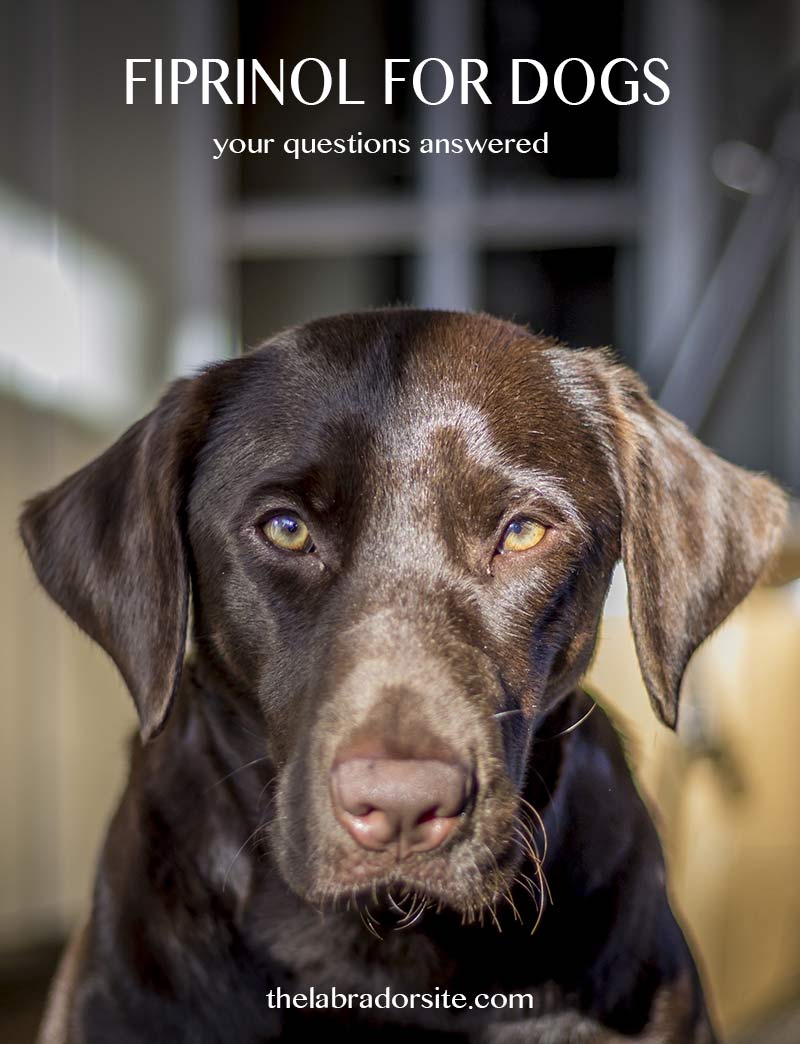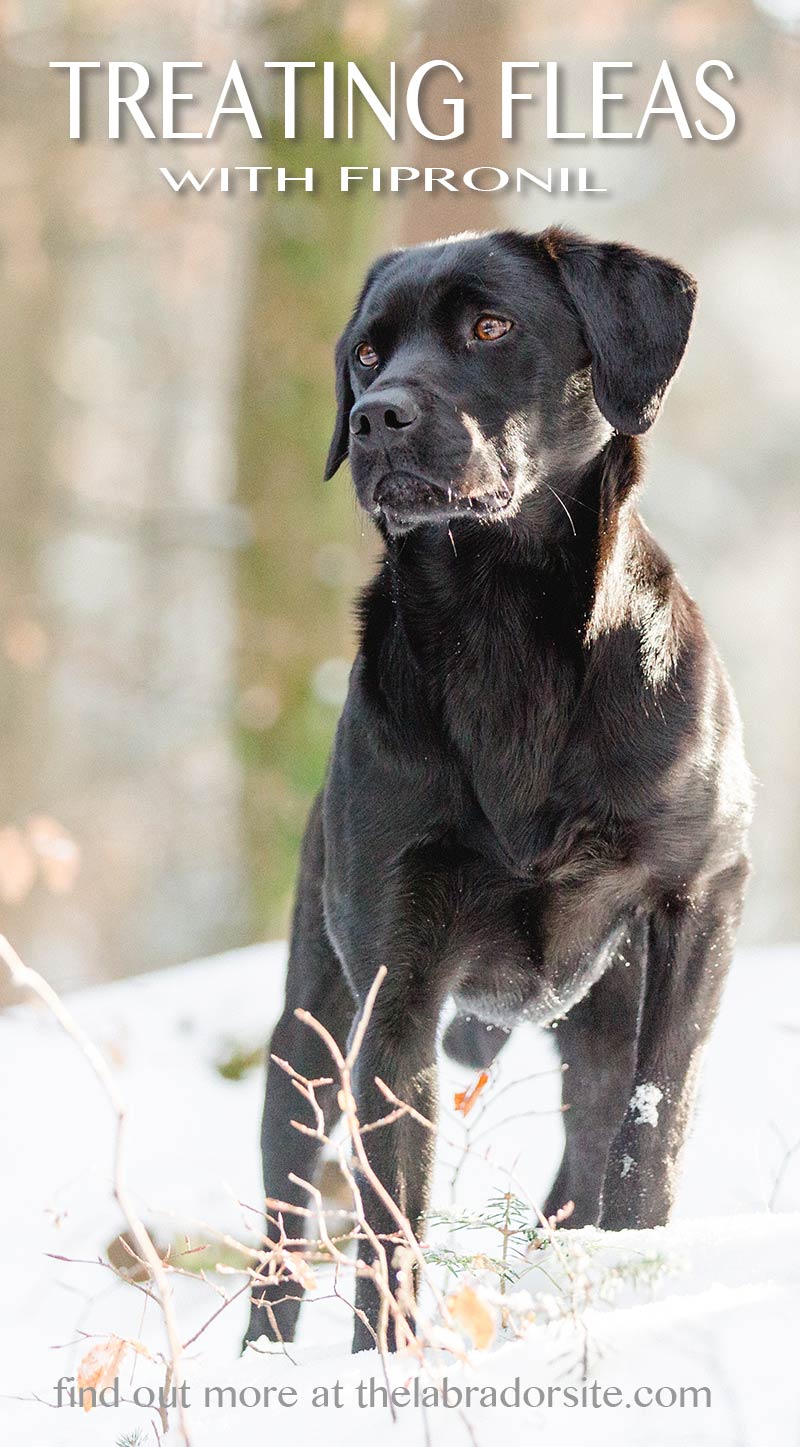Fipronil For Dogs
Fipronil for dogs is an insecticide that kills the fleas and ticks want to bite your dogs! Fleas and ticks are parasites that consume the blood of host animals. Not only can their bites be itchy and uncomfortable, they can cause painful allergic reactions or even transmit dangerous illnesses. So we protect our dogs from them by using a regular flea and tick prevention treatment.
Fipronil is the active ingredient in the flea and tick treatments Frontline, Sentry Fiproguard, PetArmor, and Hartz First Defense. Fipronil for dogs also kills ants, beetles, cockroaches, ticks, termites, weevils and other insects. It is also widely used in other industries, such as agriculture and pest control.
- How effective is Fipronil for dogs?
- Fipronil spot-on vs spray?
- Alternative products and Fipronil resistance.
- Does Fipronil for dogs have negative side effects?
Flea and tick treatments based on fipronil have been keeping our pets healthy for generations. They are very safe, and as long as you remember to re-administer them on time, they are very reliable too.
In recent years new products have reached the market which are faster acting, easier to administer, and provide longer protection. So maybe we will start to see pet owners moving away from Fipronil for dogs in the future. But it’s not going anywhere soon.
Where did fipronil come from?
Fipronil is one of the most longstanding weapons in our pet flea-control armoury. Developed by the French pharmaceutical company Rhône-Poulenc, fipronil was first marketed for treating fleas on dogs in the US by Frontline. Because fipronil is widely sold for controlling other household pests too (it’s the main ingredient in Termidor for example), I’m going to stress the obvious now: only ever use a fipronil product designed for dogs on your dog.
How effective is fipronil for dogs?
Fipronil is highly efficient at killing fleas and ticks on your dog.
Fipronil-containing products (usually Frontline or Frontline Plus*(paid link)) have been included in many effectiveness studies over the years. They consistently kill over 90% of fleas and ticks on the dogs taking part, and keep them flea and tick free for at least four weeks. There are some public concerns about resistance, and we’ll look at those below
What conditions is fipronil used to treat?
Fipronil for dogs kills adult fleas and ticks on your Labrador, whether they have already bitten him, were waiting in his fur when you applied the treatment, or if they hop onboard in between treatments. The Frontline Plus range, which contains fipronil and S-methoprene, also prevents flea larvae maturing into adult fleas.
Fipronil does not treat flea- or tick-borne diseases, but there is some early evidence to suggest that fipronil can inhibit the transmission of Lyme disease and canine ehrlicosis from tick to dog in the first place (it’s not understood how yet).
Your vet might also prescribe a fipronil product such as Frontline to treat ear mites in dogs, although they seem to be falling out of favor these days to other, faster-acting products. Finally, fipronil products will treat chewing lice infestations in dogs.
What forms does fipronil for dogs come in?
Fipronil for dogs comes as spot-on treatments or sprays. Each has its own uses, pros, and cons
Fipronil spot-on for dogs
Spot-on treatments are pre-measured doses in single use pipettes, which you empty onto the back of your dog’s neck. Different doses are available, and you choose the correct one based on the weight of your Lab. Even the biggest dose, for dogs over 40kg, is less than a teaspoon. It’s important to get the dose right, so your veterinarian will weigh your dog before prescribing the appropriate product
Fipronil spray for dogs
Sprays*(paid link) on the other hand come in a single concentration, and you calculate how much to apply based on the weight of your lab and the instructions on the bottle.
Usually the correct dosage means saturating your dog’s coat, and for this reason spot-on treatments are much more popular, because they are quicker and less messy. Fipronil spray does have the advantage occasionally however. For example if you have several animals of different sizes and want to buy one product rather than several separate products. As we shall see a bit later, it also appears to bring fewer unwanted side effects.
How does fipronil work?
Have you ever wondered how a tiny pipette of flea treatment applied to the back of your Labrador’s neck can protect their whole body from fleas for an entire month? And how such a small dose of anything can kill so many fleas?

Well, here are some answers. For a start, only about one tenth of that tiny Frontline pipette contains fipronil. (Just think how potent an insecticide that makes it!) The rest of the contents are inert oils to help the fipronil spread across the surface of your dogs skin. As it spreads, it gravitates to the hair follicles and sebaceous glands. The fipronil solution sinks into the sebaceous glands and forms tiny reservoirs there. So the amount of the fipronil on the surface of the skin constantly replenishes whenever the glands secrete sebum. So that’s how it goes on working for a month, even after your dog has had a bath or swim.
When an insect comes into contact with fipronil, it acts on their central nervous system by triggering all the nerve endings to act constantly. This overwhelms their nervous system with signals and causes it to fail, ultimately killing them. Only tiny amounts of fipronil are required because it acts on an incredibly minute molecular level, and flea and tick’s nervous systems are not big.
Is fipronil right for your dog?
Fipronil based products for treating fleas and ticks have had a huge stake in the market for decades now. The only way to be sure you’re choosing the right flea and tick control treatment for your Labrador is by consulting your veterinarian when you choose it.
They will consider your pet’s full medical history, and discuss your preferences (for example whether you’re more comfortable administering a spot on treatment or an oral treatment) before making a recommendation. They will also take into consideration other pets living at home, since some treatments are particularly toxic to other species. Fipronil is highly toxic to fish, for example.
You might find that settling on the right treatment for you is a matter of trial and error. Unfortunately there is not a handy list of criteria that guarantees fipronil (or any other flea treatment) is the best for you!
Can I buy fipronil over the counter?
In some regions, Fipronil tick and fleas treatments can’t be sold over the counter without a prescription. Some websites also require a prescription, although others don’t. If you’ve never used fipronil for dogs before, always consult your veterinarian before using it for the first time, and get a prescription.
Flea treatments all look more or less the same, but your vet will know if your dog is more at risk of experiencing an adverse reaction to the active ingredient in one than another.
Alternatives to fipronil
Fipronil is a slow acting insecticide, which means it takes up to 48 hours to kill the fleas and ticks on your Labrador. In other settings, being slow acting is an advantage. For example when used to treat ants or cockroaches in the home. It gives a chance for treated insects to get back to the nest, where they poison others too.
However, when it comes to treating fleas and ticks on our dogs, fipronil might be losing its edge to other faster-acting treatments. CAPSTAR*(paid link) and K9 Advantix*(paid link) spot on treatments both outperformed Frontline over three hour and eight periods in a 2005 study.
Some newer products also protect against re-infestation for longer. This is important because most of the time when flea treatment fails, it’s because it hasn’t been re-administered promptly when it was due. Bravecto oral treatments successfully prevented re-infestation for three months in a 2014 trial.
What about resistance to fipronil?
It is quite common to hear dog owners and their veterinarians commenting that fleas may be becoming resistant to fipronil. Resistance means that the target of the insecticide – in this case the fleas on your dog – is becoming less susceptible to its toxic effects. If fleas are becoming resistance to Fipronil then this would result in the product failing to kill the fleas that it come into contact with.
However, product failure can be caused by factors other than resistance. And it is sometimes difficult to disentangle these – especially under home conditions. Resistance – or lack of it – can be tested under laboratory conditions. And a recent study published in 2016 found that no significant reduction in the susceptibility of fleas to fipronil. The study concludes that the failure of the product may be due to “operational factors such as failure to adequately treat the pet and follow label directions”.
If you’re using a fipronil product at the moment but you’re not completely happy with it, check that you are following the instructions correctly. Then ask your vet if another treatment would be more suitable for you.
When not to use fipronil
Fipronil-based products are not suitable for puppies under eight weeks old or dogs weighing less than 2kg. Bear in mind this might preclude many toy dogs for their entire lifetime. If your Labrador has a much smaller canine companion living at home too, your vet will help you choose an appropriate way to protect them from ticks and fleas too.
Don’t use a fipronil for dogs product if you have already used another flea or tick treatment in the last month. If you think the first treatment isnt working, ask your vet for advice.
How to use fipronil for dogs
Always use fipronil products in accordance with the instructions included in the packet. If you mislay the instructions, try looking on the manufacturers website. For example the instructions for Frontline together with other frequently asked questions are here on their website. Wait until the application site is dry before petting your dog again.

Researchers at Murray State University found that low concentrations of Frontline are transferred to owners’ hands after five minutes of petting for up to four weeks after treatment. The quantities are far too low to ever cause harm to the average dog owner. But it’s a sage reminder to wash your hands after petting your dog, and make sure kids wash theirs.
Don’t bathe your Lab or let them go swimming for two days after treatment. Remember that if you are raising your Lab from a pup, you’ll need to keep track of their weight to make sure you’re giving the correct dose each time.
Side effects of fipronil and when to report them
Fipronil has very low toxicity to dogs, humans and other mammals, so adverse reactions are rare. The most common side effect of using fipronil for dogs is skin irritation or hair loss at the application site. Spot on treatments are occasionally linked to stomach upsets. Especially if pets were able to get hold of and chew the pipette. They are also seen with neurological problems including lethargy, lack of appetite and excess drooling.
Interestingly, no cases were recorded of spray treatments causing stomach upsets or neurological problems. However that’s not to say that they aren’t possible. It’s still important not to shut a freshly sprayed pet in a confined space, due to the risk of inhaling fumes.
Consult vet if you are ever worried about side effects from using a flea or tick treatment. If they ask you to go in for an examination, take the packaging of the product you have been using.
Affiliate link disclosure: Links in this article marked with an * are affiliate links, and we may receive a small commission if you purchase these products. However, we selected them for inclusion independently, and all of the views expressed in this article are our own.

Free Labrador Updates!
Get my training tips, news, reviews, and the latest from The Labrador Site delivered to your inbox



Is it safe if a dog ingests fipronil
tengo una perrita Podder de 4 años ylehe estado aplicando Amitrax para combatir las garrapatas, hastala semanapasada Puedo aplicarle Fiproni sinningún problema? gracias
We have an 18 mo old Lab and live in the sagebrush/steppe area of Washington State where ticks are common in Spring/Summer/Fall. We’ve been using Frontline Plus spot treatment, but find it very difficult to get it to our pup’s skin with his thick undercoat. I’ve seen a suggestion to apply it the area under his chin – where the undercoat is thinner. This isn’t mentioned on the Frontline website. Any opinion(s) or other suggestions?